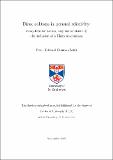Files in this item
Dirac solitons in general relativity : many-fermion states, singular solutions & the inclusion of a Higgs mechanism
Item metadata
| dc.contributor.advisor | Hooley, Chris | |
| dc.contributor.advisor | Horne, K. (Keith) | |
| dc.contributor.advisor | Dritschel, David Gerard | |
| dc.contributor.author | Leith, Peter Edward Duncan | |
| dc.coverage.spatial | v, 156 p. | en_US |
| dc.date.accessioned | 2022-11-28T16:58:35Z | |
| dc.date.available | 2022-11-28T16:58:35Z | |
| dc.date.issued | 2022-11-29 | |
| dc.identifier.uri | https://hdl.handle.net/10023/26508 | |
| dc.description.abstract | The study of gravitationally localised quantum states, in which quantum particles are bound together by their mutual gravitational interaction, has been a topic of considerable research for over 50 years. Stemming from John Wheeler's initial concept of an electromagnetic 'geon', focus quickly converged on scalar fields with the introduction of the objects today referred to as 'boson stars'. It was not until more recently, however, that the fermionic sector was properly addressed by Finster, Smoller & Yau, who successfully constructed the first numerical solutions to the coupled Einstein--Dirac system. The resulting 'particle-like' objects, comprising pairs of neutral fermions, have become known as 'Dirac solitons' or 'Dirac stars', and have been the focus of significantly less study than their bosonic counterparts. This thesis aims to expand the knowledge of Dirac solitons in a number of ways. First, we conduct a detailed study of the many-fermion system (up to a total of 90 fermions), and interpret the structure of the resulting solutions in terms of a 'self-trapping' effect. We also find somewhat unexpected results for the behaviour of the excited states of these many-fermion solitons. Second, we present particle-like solutions to the minimally-coupled Einstein-Dirac-Higgs system, and show that, in the presence of strong coupling, a mass-scale separation can occur, in which the total mass of the constituent fermions far outweighs the gravitational mass of the state. Finally, we introduce new singular solutions to the Einstein-Dirac system, including the first normalised analytic solution. The properties of these are somewhat unusual, but we show that many are related (and indeed can be smoothly connected) to the non-singular Einstein-Dirac states. | en_US |
| dc.language.iso | en | en_US |
| dc.subject | Quantum gravity | en_US |
| dc.subject | General relativity | en_US |
| dc.subject | Dirac fermions | en_US |
| dc.subject | Solitons | en_US |
| dc.subject | Bound states | en_US |
| dc.title | Dirac solitons in general relativity : many-fermion states, singular solutions & the inclusion of a Higgs mechanism | en_US |
| dc.type | Thesis | en_US |
| dc.contributor.sponsor | Engineering and Physical Sciences Research Council (EPSRC) | en_US |
| dc.contributor.sponsor | University of St Andrews. St Leonard's Scholarship | en_US |
| dc.type.qualificationlevel | Doctoral | en_US |
| dc.type.qualificationname | PhD Doctor of Philosophy | en_US |
| dc.publisher.institution | The University of St Andrews | en_US |
| dc.identifier.doi | https://doi.org/10.17630/sta/234 | |
| dc.identifier.grantnumber | EP/R513337/1 | en_US |
This item appears in the following Collection(s)
Items in the St Andrews Research Repository are protected by copyright, with all rights reserved, unless otherwise indicated.

